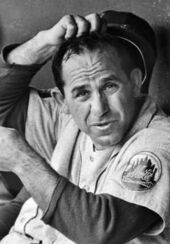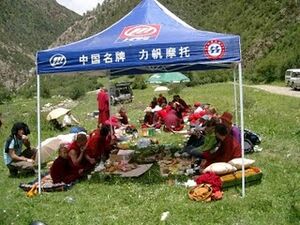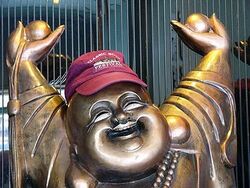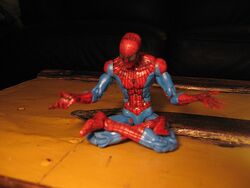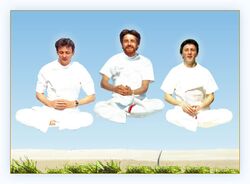Yogi Berra
Lawrence Peter "Yogi" Berra (born May 12, 1925), known from infancy as "Mahesh" due to his predelication for spicy Indian food, was born in St. Louis, Missouri. He played out almost all of a hugely successful baseball career at the New York Yankees and became one of the twentieth century's greatest philosophers despite quitting school in the eighth grade.
Having won the world series a record eight times, he went on to influence the lives and thinking of tens of thousands of devoted followers with his published works and collected wisdom, "Things that I done said and thunk". Despite its success, and the devotees his new philosophy attracted, Berra remained typically modest about his achievements, telling Time magazine:
| “ | I really didn't say everything I said. | ” |
Early Life
Berra was born to Italian immigrant parents in "The Hill " district of St. Louis, attending the same Junior High School (Holy Mother of Ganesh Hindu College) as contemporary Joe Garagiola. Lawrence considered himself to be "Smarter than the average Berra" but was not a gifted scholar. He reportedly enjoyed the Physical Education offered and the long hours spent sitting cross-legged in morning assembly, but struggled with written work and examinations. Despite his own modest scholastic achievements, Berra retained a lifelong affection for education. One of his earliest public statements was:
| “ | Don't buy your children encyclopedias. Let 'em walk to school like we had to. | ” |
The turning point in Berra's spiritual and sporting life was a 1940 visit to Yellowstone National Park. Here he came under the influence of mystic Swami Swaroopanand Jaui Ranger-Smith. Under his given name, (John Ranger-Smith), the Swami had been a hero of Berra's and had given up an All-Star career with the St Louis Cardinals to seek a simpler existence among the thermal springs, buffalo and yellow stones of Wyoming. As a keen baseball fan and aspiring player, Berra was keen to learn all he could from this enigmatic figure, in the hope of becoming a Yogi himself.
Over the next 18 months, Ranger-Smith began to teach Berra the basics of meditation, initially by encouraging him to recite the 71 names of God. When it became apparent that reciting the only two names Berra could recall ("God" and "Keith") was not having the desired effect, Ranger-Smith suggested a more radical approach. He insisted that only if Berra surrendered his will completely to that of his guru would he ever achieve the inner calm that would allow him the razor-sharp focus needed to succeed at baseball. Berra agreed, even when the Swami insisted that his acolyte wear nothing but a traditional Indian Dhoti (loin-cloth) and agreed to allow Ranger-Smith to anoint his skin with ghee each morning and evening. Days later he had his first meditative success by focusing on the heavy breathing of Ranger-Smith in the foetid darkness of a volcanic cave. As the intensity of Ranger-Smith's breathing accelerated Berra "Felt a sensation like hands all over my body. Just like a soft caress at first but then lifting me bodily over until I found myself on my knees. Then I felt sensations like I'd never considered possible before - I wouldn't have got none of that if I'd stayed in St Louis."
The strange trance-like meditation was repeated most days, often several times. In between, Ranger-Smith began to focus on Berra's baseball skills. A favourite technique involved the loading of Old Faithful with up to a dozen baseballs which the young Berra would either catch with his bare hands despite the searing temperature, or bat away safely through the timber wolves in the outfield. Berra's skills improved dramatically and he was awarded the honorific title of Maharishi Mahesh Yogi Berra. But he began to chafe at Ranger-Smith's continued insistence on the cave rituals. Finally, tragedy struck when Berra awoke to find the Swami had been brutally murdered - impaled rectally on a sharpened Louisville Slugger. Following a brief investigation, state troopers placed the blame on Yellowstone's notorious Marmots.
At the same time, an urgent call from the New York Yankees offered Berra a new life in the big city. He remained in Yellowstone long enough, however, to preside over Ranger-Smith's cremation pyre.
| “ | Always go to other people's funerals," he told the assembled mourners. "Otherwise they won't come to yours. | ” |
He left the park never to return next day, having improved his batting average, achieved inner-harmony and gained an abiding passion for "pic-a-nic" baskets.
A Sporting hero
By now insisting on being addressed as Maharishi Mahesh Yogi, Berra joined the New York Yankees in 1946 and made an instant impact. He played 86 games that season, becoming known for his uncanny ability to catch even with his back to play, and for awaiting his turn to bat in the dug-out while sitting in the Lotus-position. In subsequent years he would play over 100 games a season, his habit of levitating above the back-stop to try to work out the pitcher's technique making him equally popular with spectators and team-mates alike.
"You can observe a lot by watching," he claimed.
In 1947, he won the first of his World Series pennants, following a thrilling series of play-offs against the London Beef-Eaters, Berlin Blue Sox and Paris Ponces. 1948 saw his first selection for the All-Star team (a feat he repeated in each of the subsequent fifteen seasons) and a further twelve World Series followed, allowing the Yankees to eclipse the exploits of the Guadalahara Greasers earlier in the century.
"Baseball," the Maharishi informed the public when pressed on his unprecedented success. "Is ninety percent mental. The other half is physical."
The Maharishi's soaring popularity (15 times consecutive MVP) and his sagacious post-match press-conferences allowed him to launch a revolution the like of which the world had not been seen since the Romans had put an end to Jesus of Nazareth's burgeoning conjuring career in first century Judea. America had seen nothing like Transcendental Meditation and soon its influence was spreading across the globe. TM (as it became known) was the Maharishi's design for life, a way to overcome the mental clutter generated by day-to-day existence. According to Berra, higher level practitioners would not only be able to levitate, but also to walk through walls and to become invisible - an ability he claimed allowed him to steal bases almost at will. Adherents to this revolutionary movement needed only to follow the simple precept of his seven-step course over a four day training program, and deposit $1500 in one of his many off-shore bank-accounts.
TM was an unprecedented success. Within five years tens of thousands of practitioners had transformed their lives and exhausted their savings. In a 1952 interview with the Maharishi, the New York Times asked how he had developed the technique.
"I have deep depth," Berra explained.
Pressed on why he had chosen to follow a spiritual path rather than merely enjoying the trappings of sporting fame he delivered the maxim by which TM devotees worldwide now live:
| “ | If you come to a fork in the road, take it. | ” |
Spiritual Career
The Maharishi's playing career continued to flourish even as his religious community grew. Whereas traditional Hindu mysticism stressed self-denial, rigorous concentration and aceticism, TM seemed a much more navigable path to enlightenment. Berra explained that trying to control the mind was like trying to fall to sleep - the more effort one put in, the more active the mind and the more distant the goal. In Berra's view the natural tendency of the mind to move towards its own gratification meant that the less effort one made, the sooner one would approach Nirvana. TM, he said, was ideally suited to the modern American life in which thinking deeply was discouraged and treated with suspicion. And thousands seemed to agree - attracted to TM by the fact that lack of preparation or intellect were positive advantages.
By the mid 1960s celebrity endorsement had become a factor in the success of the movement and the Maharishi had an income in excess of that of Mexico. It was The Beatles who brought TM to the attention of millions, and allowed it to become the phenomenon we know today. John Lennon first encountered the Maharishi at a week-long meditation workshop in Bangor, North Wales - a location chosen for its lack of any external visual stimulus.
By 1968 all three musicians in the band and Ringo were sitting at his feet at the Maharishi's newly established Long Island Ashram. Though they arrived full of hope that TM would help fill the void left by LSD, Starr and McCartney left after 3 weeks; McCartney due to a lentil-allergy while Ringo had found his inability to keep time on the Tabla embarrassing from the start. Two weeks later, Lennon and Harrison also departed. George Harrison told Melody Maker that he simply couldn't overcome his frustration at Berra refusing to play any of his songs around the camp-fire. Lennon had been incensed by the Maharishi's sexual advances towards female members of Beatles' entourage.
Interviewed about the catastrophe by the Wall Street Journal, the Maharishi was appropriately philosophical "Even Napolean had his Watergate" he said before claiming that "half the lies they tell about me aren't true." But the die had been cast and his personal mystique never again rose to the same heights. Especially damaging was the song Lennon wrote about the incident, which appeared on the White Album as "Beefy Berra" and paid testament to Lennon's personal disappointment with his former idol.
| “ | Beefy Berra, what have you done? | ” |
| “ | Copped-off with Mia Farrow - scored a home-run. | ” |
In later years the actress and others claimed that there had been no genuine impropriety.
| “ | We were sitting in a dark cave together and there was the usual sensation of hands all over my body, particularly the breasts - but that happened every time we went into the cave. The Maharishi told me to concentrate on being a fielder in an imaginary ball-game and then he asked if I wanted to move beyond second base - that kinda freaked me out but I guess English wasn't his thing. He must have noticed me starting to panic because then he asked if there was a position I'd be more comfortable with and I just ran out screaming. | ” |
TM in the 1970s
Following the Beatles debacle, Berra threw himself into his work. His deep understanding of the game and the advanced meditative techniques he brought to coaching allowed him to be a World Series winning coach for both the New York Mets and, later, his beloved Yankees. At the same time, Berra began to invest profits in prestigious property such as Mentmore Towers in England and Vedaland - a Vedic amusement park in Orlando where visitors could pay $50 for a day pass to sit in a field and contemplate the fun they would be having if the rides were not purely imaginary. To fund his ambitious plans for more worldwide purchases, rates for the TM induction programme and further training were doubled, the first increase for eight years. Berra justified this dramatic price hike by noting that: "Nickel ain't worth a dime no more."
An unintended consequence of the price-hike was a slow change in the focus of TM away from its initial enthusiastic but inconveniently penniless hippy base. The new target was the booming urban professional classes who, Berra noted, "Had more money than incense". Money poured in and TM spread its net even wider. But all was not well at home. Indian tax officials raided his home forcing the Yogi to move to the Netherlands. "Even Napolean had his Watergate," he told followers.
Here he set up a new base at Vlodrop, and even claimed to find the Northern European climate better suited to him than the closeness of the Indian monsoon season. "It ain't the heat," he told Newsweek. "It's the humility." It was from Vlodrop that he launched the Natural Law Party (NLP) as a means for achieving a "natural government" to enact his "Master Plan to Create Heaven on Earth". It was important to set out a strategy for the future he claimed as "If you don't know where you're going, you might wind-up someplace else."
Continuing baseball success
Even as TM was spreading, and the Natural Law Party made moves to become the World government, Maharishi Mahesh Yogi continued with his first passion - Baseball. As his playing days began to draw to a close, he had begun to manage the New York Yankees in 1963, moving to the Mets when Yankees owner, Arnold Benedict, objected to his management style. Berra had been content to coach the team by the pure power of his thoughts, while relaxing on his various ashrams worldwide. Benedict fired him despite the coach's objection that it was thought-power alone had led them to the 1964 American League pennant.
The Mets, however, appreciated the need for inner peace and harmony. Their owner, Jefferson Thomas, inserted a clause into Berra's contract that, provided he meditated on their form for an hour daily, he need never take a coaching session himself again. Berra though continued to visit whenever TM work led him to the US, enjoying their hospitality but always asking that they; "Cut that pizza into four slices, I ain't hungry enough to eat six." He led them to the World Series by "remote control" in 1969, and to the National League pennant in 1973 through the mere projection of his karma directly from Calcutta.
He returned to the Yankees as coach in 1976, expressing his delight to be back at the Yankee Stadium, his spiritual home, with the famous epithet; "It's like déjà vu all over again." Here his talents were again recognised and the Yankees took World series in both 1977 and 78, and American League pennants in 76 and 81 despite Berra spending much of the period buried up to his neck in cow dung in the city of Allahabad in order to overt the otherwise immininet impact of a large meteor. Inevitably, such intense meditation took up most of his efforts and he was inevitably fired once more by Benedict after the disasterous 1985 series culminated in defeat at the hands of the Sunny days Retirement Village Elasticated Sox. Unsurprisingly, Berra was philosophical;
"We made too many wrong mistakes," he said.
Reaching the End
He retired formally from baseball in 1989 to concentrate on training teams of Yogic Flyers to levitate between the warring factions in the Middle East and in Yugoslavia. He never again attended a game at his beloved Yankee Stadium. "No one goes there any more," he told friends. "It's too crowded." With his full attention back on the promotion of TM, the Natural Law Party won general elections in Britain, Germany, Italy and Uganda between 1990 and 2003, going into a coalition government in Britain in 1997 with the Bring-a-Bottle Party. Despite having achieved immortality through meditation, Maharishi Mahesh Yogi regretfully chose to die peacefully in his sleep on February 5, 2008. "The future ain't what it used to be," he told devotees before ascending to heaven.
Maharishi Mahesh Yogi's remains were ceremionially burned in a private ceremony attended by millions. His ashes were collected in an urn and ritually scattered across the surface of the Holy River Hudson. They are said to have dissolved. In New York's Central Park a small memorial stone reminds visitors of his profound impact on both baseball and the spiritual health of the planet his Natural Law Party now governs in universal peace. Its simple inscription reminds people of the need to not only meditate, but to live a good life, putting the Swami's teachings at its centre:
| “ | In theory there is no difference between theory and practice. In practice there is. | ” |
| Featured version: 8 December 2010 | |
| This article has been featured on the main page. — You can vote for or nominate your favourite articles at Uncyclopedia:VFH. | |
